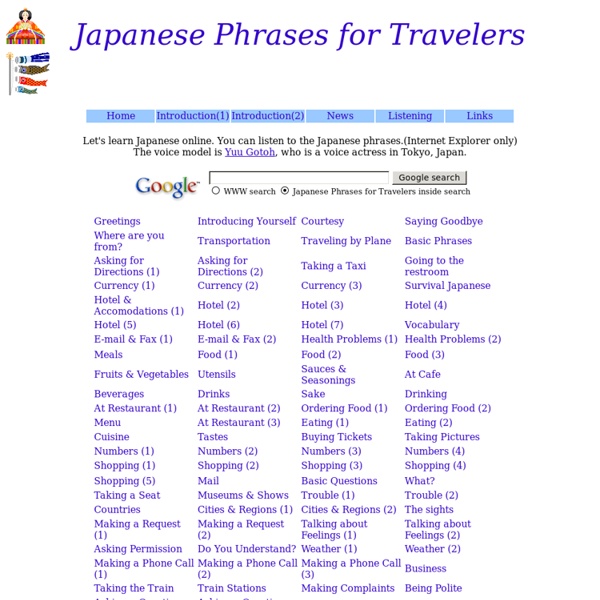



Nihongo o Narau - Learn Japanese カタカナ表 無料ダウンロード・印刷|幼児の学習素材館 無料でダウンロード・プリントアウトできる、 かたかなの アイウエオ50音表や、かたかな書き順表です。 かわいい カタカナ表 【A4・A3・A2版】 /イラストレーター がみさん かたかな表 スタンダード 【A4・A3・A2版】 かたかな表 - 書き順つき | かたかな表 - ひらがな・ローマ字つき 【A4版】 関連ページ: ひらがな・かたかな表 無料ダウンロード リンク集 >> Languages - Japanese - A Touch of Japanese - A beginners'
Learn Japanese Japanese Lessons - Ramblings of DarkMirage Introduction So, one day I was feeling bored and I decided to start a series of Japanese lessons targeted at the anime fans. These lessons are not meant to actually teach the language, but rather to give you a better understanding of how Japanese works and the various headaches faced by translators when they work on your favourite shows every week. I intend to keep this updated regularly, so keep checking back Chapters Chapter 0 – PrologueChapter I – VerbsChapter II – SentencesChapter III – KanjiChapter IV – 1st KatamariChapter V – AdjectivesChapter VI – Keigo Japanese Titbits #1 – 黄昏 (tasogare)#2 – Hentai vs. Learn Japanese : Learn Japanese Online : Learning Japanese Free Japanese language learning games Japanese games for language learning on Digital Dialects All Japanese games are free to use, do not require registration, and are suitable for kids and students of all ages. Games for learning Japanese language in HTML5 (work on current browsers) include Japanese phrases, Japanese numbers, animals quiz, basic vocabulary quiz, days and months in Japanese and a colors quiz. We also make Japanese games for moblies and tablets. Good luck in your language learning endeavours! © 2018 Digital Dialects
Learn Japanese - Nihongo.3Yen.com – Japanese Language Tae Kim's Guide to Learning Japanese A Select List of Japanese Language Study Sites These also help read a web page. You just have to copy and paste the text into the form. These are not aimed at JSL students, but if you understand Japanese fairly well, they are good. For Beginnerswww.JapanesePod101.com - Daily Perhaps a bit too much time-wasting laughing and joking around and non-study related chatting between presenters, but still very good. (See hints) If you can't easily locate the podcast feed on their website, just grab it here. Learn Japanese on the Web
TUFS Language Modules The Distribution and Number of the Speakers of Japanese Japanese is spoken by approximately 126 million people within Japan. This includes some 800 thousand people whose mother tongues are languages other than Japanese, such as Korean and Chinese. Externally, Japanese is spoken by Japanese descendants in Hawaii, North and South Americas, as well as the people in Taiwan, Korea and Micronesia, who were educated in Japanese during the Japanese occupancy in the former half of the 20th century. The Japanese we learn here Our module deals with the Japanese spoken in Metropolitan Tokyo and its outskirts.